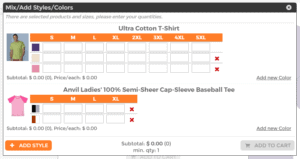
From time to time, pretty much anyone in business will have to deal with a pissed off customer and those of us in the printing world are no different. Whatever the rights and wrongs of any given complaint, it’s important to deal with it calmly, proportionately and, above all, politely – even if the customer’s attitude makes that feel very difficult. Each of us will react differently, of course and some people find it easier to keep their cool than others but complaints are always unpleasant, especially if you feel that they’re unfair, and not all customers are polite when they bring a problem to your attention. The first time that you’re faced with a complaint, it can feel like a personal attack – this is your business, that you’ve put time and sweat into and you might be inclined to respond to an angry customer as though they were attacking your favorite child.
Even if you’ve been in business for a while and have handled your fair share of problems, it’s still possible to be caught off guard by an issue that you hadn’t anticipated. This is particularly the case if you’ve diversified your business and are having to adjust to a new market, with a different sort of customer. For example, if you’re used to dealing with corporate clients and other bulk customers, you may have an expectation that your customers will have some understanding of your product before they buy. Or, if they’re not already familiar with it, they’ll probably have researched their options and may have contacted you to discuss their needs before placing the order. Now imagine that you’ve decided to take advantage of the huge market for selling custom printed products online, using an online print designer. The potential for new business in the web to print world is fantastic and it’s definitely a good business move but you need to be aware that you are dealing with a different type of customer…the general public – and you will need to communicate with them in a very different way.
Let’s dial that back a bit. Most of your new customers will be no problem at all – and with the online print designer software and the automated system taking care of everything, you won’t even have any contact with the vast majority of them. Even so, whenever you deal with the public, in any business, there are bound to be hiccups – not to mention the occasional customer who will make you weep for humanity. Whatever your private thoughts, you need to address all problems rapidly and respectfully so, for the sake of your own sanity, it’s vital to develop a plan for dealing with complaints – both the foreseeable and the ones that you never in your life thought anyone would come up with. That way, you won’t have to figure your way through each issue from square one.
Firstly, and this should go without saying, really – make sure that your terms and conditions are complete, clear and that the important points are easily findable on your website. For example, a customer who ordered a dozen size XS t-shirts by mistake might think that they should be able to swap them, free of charge, for the XL size they actually wanted. If you disagree with them, it will save you a lot of time if you can quickly send them a link to the section of your website which states that customers should check their order carefully before confirming as you are not liable for their errors. You need to set out, very clearly, not only what you cannot be held liable for in terms of errors but also whether you choose to place any limits on what customers can ask you to print. So, if you decline to print obscene material, you will need to make this clear, along with your procedure for rejecting orders of this nature. If you’ve explained all this in your terms and conditions then, if and when you do arrive at the shop in the morning to find a design that you find offensive, you should be able to cancel the order without too much further unpleasantness. You’ll need to send the customer a message explaining the decision, of course, which is why it’s very helpful to prepare a set of ‘form’ emails, so you don’t have to write the text from scratch, saving you from having to give more of your time to a distasteful matter.
Form emails are really the next major piece of a good ‘dealing with complaints’ strategy. There are lots of different methods for constructing these – there are apps that let you store text segments and most email providers will allow you to create templates. The great benefit of having a standard reply is obviously the time that it saves but also, it removes the temptation to reply in kind to an insulting email. For example, if you’ve completed and sent an order and have had no reason to think the courier didn’t deliver it until you get an aggressive email accusing you of not sending it, it’s very helpful to be able to simply click a button that fills in some text such as “Thank you for letting me know about the problem with your delivery. I can confirm that the goods were sent on (date) to (address). Please will you check the mailing address and confirm that it is correct before I contact the courier? etc.” Having a standard reply means that you’re not replying directly to the insults, which can help you to get things into perspective. It’s also more likely to calm the customer down than the reply that you might have wanted to send! A word of caution, though – make sure that the message you send really is relevant to the issue. If you send what looks like an automated response that doesn’t address the customer’s complaint, then you will only make things worse.
There are all sorts of standardized responses that you can create. Some of them will only occur to you after the first time you come across a particular problem. Obviously, most of them will need adjusting to suit the different circumstances but it can be handy to have a reminder of how you’ve dealt with similar issues in the past. It’s important to use a slightly different style, depending on where the fault for the issue lies. If you or your staff did make an error, it’s vital to make a straightforward apology. You can explain why a mistake occurred, if you think it would help but be careful not to make it seem as though you’re making excuses. If you have made an error, you will need to make redress as quickly as possible. In almost all circumstances, it’s worth offering the customer something extra as well. For example, if you accidentally sent a short quantity then you need to send the balance as soon as you’re made aware of it but you should also consider sending a little more than the shortfall, if the goods will be wanted. If there’s clearly no use for more of the same goods, then you might offer something else of value – a discount on the next purchase not only helps to restore goodwill but may secure future business. Whatever you do, remember that your customer will be reporting their experience on social media and review sites!
If you and the customer have both been let down by a third party, such as a courier, then you should sympathize with the customer and give serious consideration to bearing the cost of a replacement or refund, even if you can’t recover the cost from the party at fault. In this circumstance, it’s best to place the facts plainly before the customer, to make it clear to them that you are both on the same side in this issue. Many times, the customer will be sympathetic to you, in their turn and will try to work with you to find a solution. If the customer is still not convinced that you are blameless, then you need to stay focused on the actual facts of the case and continue to try to find an amicable solution, rather than putting too much effort into trying to justify yourself to the customer. As always, it’s important to remain polite and use simple and honest language, avoiding any undercurrent of resentment. If you’re feeling unjustly attacked, it’s easy to find yourself slipping into passive aggressive language – ‘I know YOU feel that I’m in the wrong, but…’ and so on. This may give you a moment of satisfaction but it will only make it harder to reach an agreement.
If the complaint is about something that really was the customer’s fault, then you need to take a neutral tone – whilst staying polite, of course. To take the example of the customer who ordered XS t-shirts, when they meant to order XL, you should be understanding but not too sympathetic – don’t use phrases like ‘an easy mistake to make’ or anything else that implies that it wasn’t really their fault, since that suggests that there was some other problem that caused them to go wrong, such as unclear instructions on your website. You need to avoid giving the impression that you might have been in any way to blame, in case the customer starts to think that their mistake might have been caused by something that you did! It’s usually be worth being generous, though. Offering to re-do the order at a reduced cost or, yes, even for free (within reason), might result in you making a loss on this batch but, not only might this customer be grateful enough to give you repeat business, the good reviews they might potentially leave on social media could have a much higher value. Conversely, if the customer feels badly treated, even if they’re being completely unreasonable, they might leave terrible reviews which will cost you future business. Of course, it’s important to keep a sense of perspective – you don’t want to live in such fear of the effects of social media that you become an easy mark for anyone who threatens to complain or tries to get special treatment in return for good reviews.
Social media is part of the new reality of business life, whatever sector you’re in and you can’t ignore it. Most small and medium sized businesses don’t have the resources to constantly monitor the Twitterverse and other online communities but you should regularly check the dedicated review sites – especially if you’ve had a recent problem with a customer. You should also check your own social media accounts at the very least once a day and preferably much more often. If someone has left a stinging message, you need to leave a reply as soon as possible and get damage limitation underway. Having a form of words ready to paste is invaluable but again, make sure it’s relevant to the problem. The safest way to deal with most complaint messages is to reply as soon as you can (preferably within the hour) with a polite acknowledgement of the issue and a request for the customer to contact you with further details of the problem, so that you can look into it. You need to be seen to be doing something about your customers’ concerns but you also want the complaining customer to contact you directly from this point forward, to avoid any further details being shared online, where they can be misinterpreted and aggravated by readers who were nothing to do with the original matter.
Share this post
Recent Posts


Websites For Sign Shops and Large Format Printers

What is CRM Software

Announcing DIY Plans

Feature Spotlight- Mix Styles and Colors
Newsletter
Related Posts


Websites For Sign Shops and Large Format Printers


